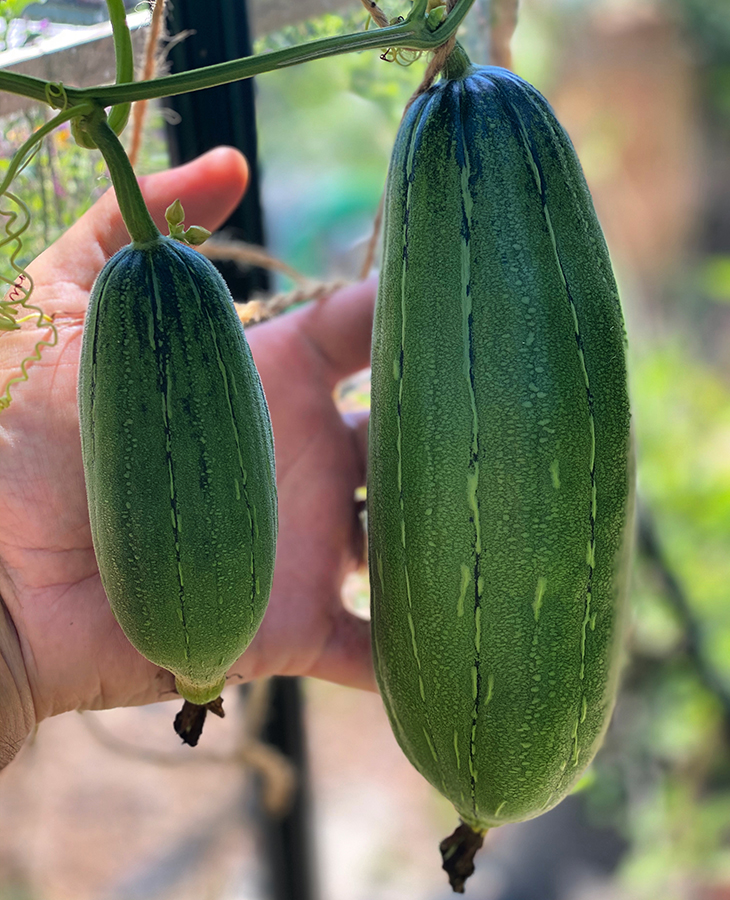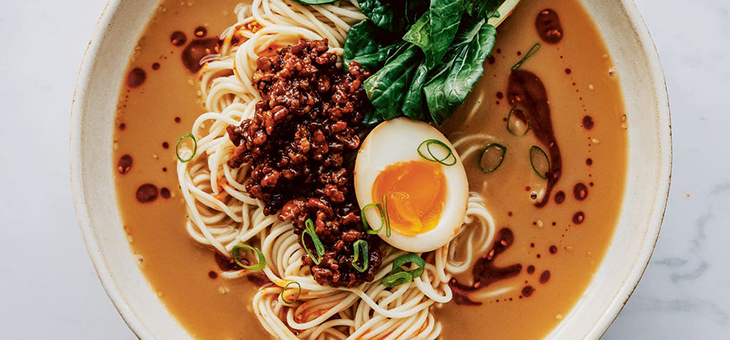Fans of Sichuan dan dan noodles will love tantanmen – it’s essentially a Japanese version of the beloved Chinese dish.
This recipe combines a flavoursome broth with homemade ramen noodles – and you can easily sub out the minced beef for soy and leave out the egg if you’re vegan.
Serves: 2
Ingredients
For the ramen noodles:
- 1/2 teaspoon fine sea salt
- 1/4teaspoon kansui
- 130g water
- 310g high-protein flour (11 per cent)
- potato starch or cornflour, for dusting
For the ramen eggs:
- 6 medium eggs
- 4 tablespoons light soy sauce
- 4 tablespoons mirin
- 250ml dashi stock (made from powder) or water (cold)
For the meat sauce:
- 1 tablespoon neutral oil
- 200g minced beef or 100g each of minced beef and pork
- 1 teaspoon Chinese five spice
- 2 tablespoons Shaoxing rice wine
- 2 tablespoons sweet bean sauce or hoisin sauce
- 1/2 teaspoon dark soy sauce
- 1/2 teaspoon freshly ground black pepper
To season the bowls:
- 1/4 teaspoon ground Sichuan peppercorns, sieved
- 1 teaspoon toasted sesame seeds
- 1/2 teaspoon light brown sugar
- 2 teaspoons Chinkiang black rice vinegar
- 4 teaspoons light soy sauce
- 2 tablespoons Chinese sesame paste
- 2 tablespoons Sichuan chilli oil (or to taste)
To serve:
- 2 pak choi, leaves separated
- 200g fresh ramen noodles or 100g dried ramen noodles
- 1 ramen egg
- 600ml chicken or veg broth
- 1 spring onion, finely sliced
Read: Fried Noodles and Greens

Method
For the ramen eggs: bring a pan of water to a rapid boil. Lower the eggs gently into the water and cook for exactly six minutes. Remove from the water and run under very cold water for three to four minutes, or plunge into a bowl of water and ice cubes. When completely cool, peel the eggs.
Combine the soy, mirin and dashi. Submerge the eggs in the liquid and cover with baking paper. Alternatively, place the eggs in a sealable container or resealable plastic bag filled with the liquid. Leave in the fridge overnight to chill and marinate before eating. Will keep in the fridge for up to five days.
For the ramen noodles (if making): combine the salt, kansui and water, pour over the flour and mix until dry straggles have formed. Bring the dough together into a ball. To do this, apply pressure using the palm of your hand in a downward motion. Continue to do this until the straggles of dough are forced together to form a rough ball and cover with a damp dish towel, and rest for 15 minutes.
In the meantime, set up your pasta roller. Clamp it firmly to your worktop as the dough is extremely hard. Remove the dough from the bowl. Take a rolling pin and press firmly onto the dough, section by section, until it is thin enough to pass through the pasta roller on its widest setting. Pass the dough through. What will emerge may be quite rough and ragged – this is okay! If the sheet has separated, or holes have appeared, don’t worry. Pass the dough through again on the widest setting and repeat this step until you have one complete sheet of dough, with no holes. Reset the pasta roller setting to the next narrowest setting. Pass the sheet of dough through. Reduce the setting once more, to the third narrowest setting. Pass the dough through.
Read: Taiwanese Pumpkin Rice Noodles
Now fold the dough in half, lengthways, and pass through the pasta roller on the widest setting. Repeat this sheeting and folding process until you have a smooth and even-textured sheet of dough. The edges of the sheet may have become dry and cracked – this is a result of the folding – but this is okay. Gently fold the sheet of dough in half and leave to rest for 30 minutes, covered with a clean dish towel.
Once rested, unfold the dough sheet and pass through the pasta roller again to create a thin sheet – on my pasta roller this is a number five. Pass the dough through the cutting attachment, then lightly dust the noodles with potato starch or cornflour to keep the strands separate.
Place in a sealed container or freezer bag. They get better with age and resting them for 24 hours will improve the texture. They are good for up to five days in the fridge, but can also be enjoyed straight away. Cook the noodles in boiling salted water for 90 seconds. Rinse under cold water and serve in your chosen recipe.
For the tantanmen: put a large pan of salted water on to boil. Blanch the pak choi for 30 seconds, scoop out, then set aside. Cook the noodles in the same water until al dente, according to the packet. Drain, then rinse in plenty of cold water to stop them from sticking together. Set aside.
To make the sauce, heat the neutral oil in a heavy-based frying pan or wok over a high heat. Add the minced meat and let it caramelise for at least one minute, without stirring. Stir, then continue to cook for five to six minutes until browned all over. Add the Chinese five spice and cook for 30 seconds. Pour in the rice wine, stir again, then add the sweet bean sauce or hoisin, dark soy sauce and black pepper. Mix well, turn down the heat and cook for another two minutes.
Read: Simple and Delicious Laksa Noodle Soup
Add the ramen egg to a mug of boiling water to gently reheat. Heat the broth until steaming.
To assemble, divide all the bowl seasonings between two serving bowls. Pour in the hot broth and mix well to combine. At the last moment, add the noodles, top with meat sauce, half a ramen egg each, sliced spring onions and the blanched pak choi.
Bowls & Broths by Pippa Middlehurst is published by Quadrille, available now. Photography by India Hobson & Magnus Edmondson.
Have you ever made your own ramen noodles? Please share how the recipe turns out for you in the comments section below.
– With PA
If you enjoy our content, don’t keep it to yourself. Share our free eNews with your friends and encourage them to sign up.

